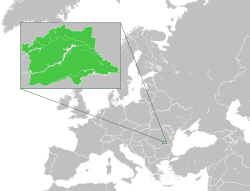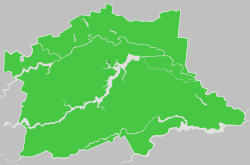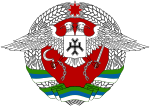Snagovian People's Republic
Snagovian People's Republic | |
|---|---|
| Anthem: "Te slăvim, Snagovule!" Тє слъвим, Снаговулє! We glorify you, Snagov! | |
Territory controlled by the Snagovian People's Republic in dark green; territory claimed but not controlled in light green | |
| Status | Active |
| Capital | Siliștea |
| Largest village | Ciolpani |
| Official languages | Romanian (Latin and Cyrillic scripts) |
| Ethnic groups (Estimated as of 2023) |
|
| Religion | Snagovian Orthodox Church Romanian Orthodox Church |
| Demonym(s) | Snagovian |
| Government | One party semi-presidential federal republic |
| Štefan Marius Snagoveanu | |
| David Robert Davidovici | |
| Albert Henri Jinga | |
| Legislature | Supreme People's Assembly |
| Independence from Romania | |
• Declaration of National Rebirth adopted | 18 June 2020 |
| Area | |
• Total | 254.68 km2 (98.33 sq mi) |
• Water (%) | 3.7% |
| Population | |
• 2022 estimate | 23,500 |
• Density | 92.27/km2 (239.0/sq mi) |
| Membership | 55 |
| HDI (2021) | ▲ 0.963 very high |
| Currency | Snagovian ruble (₽) |
| Time zone | UTC+2 (EET) |
• Summer (DST) | UTC+3 (EEST) |
| Driving side | right |
Snagov (Romanian Cyrillic: Снагов) (/snɑːˈɡɔːv/ ![]() (Listen) (help·info)), officially the Snagovian People's Republic (Romanian Cyrillic: Рєпублика Популаръ Снаговєанъ), is a self-proclaimed proto-state and separatist movement located in Eastern Europe. It is located in southern Romania, envisaging to consist of the territory surrounding Lake Snagov, officially claiming land from the communes of Snagov, Gruiu, Ciolpani, Nuci and Balta Doamnei. The Republic has complete sovereignty over a small strip of land, the Cernograd Sovereign Raion. These territorial claims are meant to roughly match with the definition of the geographical boundaries of the Snagov region, which is the homeland of the Snagovian people, an unrecognized Southern Slavic ethnic group related to the Bulgarians, having their own culture, history, language and identity. They form the majority in the settlements located in the Snagovian plain, a subdivision of the larger Vlăsia plain. The People's Republic is comprised of rural communities and thus has no cities. The capital village is Siliștea, located in the northern parts of the country. The Snagovian People's Army is a ceremonial military force, as the Snagovian government claims to be a peaceful movement.
(Listen) (help·info)), officially the Snagovian People's Republic (Romanian Cyrillic: Рєпублика Популаръ Снаговєанъ), is a self-proclaimed proto-state and separatist movement located in Eastern Europe. It is located in southern Romania, envisaging to consist of the territory surrounding Lake Snagov, officially claiming land from the communes of Snagov, Gruiu, Ciolpani, Nuci and Balta Doamnei. The Republic has complete sovereignty over a small strip of land, the Cernograd Sovereign Raion. These territorial claims are meant to roughly match with the definition of the geographical boundaries of the Snagov region, which is the homeland of the Snagovian people, an unrecognized Southern Slavic ethnic group related to the Bulgarians, having their own culture, history, language and identity. They form the majority in the settlements located in the Snagovian plain, a subdivision of the larger Vlăsia plain. The People's Republic is comprised of rural communities and thus has no cities. The capital village is Siliștea, located in the northern parts of the country. The Snagovian People's Army is a ceremonial military force, as the Snagovian government claims to be a peaceful movement.
The document which officially established the state is the Snagovian Declaration of National Rebirth, signed on 18 June 2020. Snagov is described as a one party semi-presidential federal republic. Constitutionally, the administrative subdivisions of the state enjoy a high level of autonomy. Snagovism is the official state ideology, being developed by Ștefan Marius Snagoveanu in his book, "Manifestul Snagovist". The core principles of the ideology are Snagovian nationalism, agrarian socialism, environmentalism, and traditionalism. The National Snagovist Front is the sole political party of Snagov, however, it more importantly functions as a local party in Romanian politics.
The SPR is a full member of the Grand Unified Micronational since 11 February 2021.
Etymology
The name "Snagov" comes from the Proto-Slavic sněgъ, itself having as origin the Proto-Balto-Slavic snáigas, meaning "snow". The "-ov" suffix is of slavic origin, and is commonly used in names, meaning "of". Thus the literal translation of "Snagov" is "of snow". The first attested use of this name was in a deed of Mircea the Elder, dated 23 March 1408. The deed was referring to the Snagov Monastery.
It's widely believed hat the name has been used to refer to the region since the Slavic migrations to the Balkans in the 6th century. The Slavs probably naming it after the sheets of snow settling on the surface of the frozen Lake Snagov.
In the past, the name was written with a Z instead of an S, thus, "Znagov". It appears as such in many old documents.
History
Ancient history
The shores of Lake Snagov and its surroundings have been inhabited by humans since the Neolithic Age. The first known people to settle in the area being the Proto-Indo-Europeans, which by the 8th century BC became the Thracian people. The tribe that lived around the Lower Danube and surroundings in today's Northern Bulgaria and Southern Romania were the Getae. Archeological evidence suggests the first human settlement in the Snagov region lived on Vlad Țepeș island, where the Snagov Monastery was built. For a very long time, these people lived in groups that kept moving every 7 to 20 years, from one place to another, usually choosing the higher banks of the lake. In the 7th century BC, the Getae came into contact with the Greeks, establishing economic and cultural exchanges with the ones living in the colonies on the western side of Pontus Euxinus, nowadays known as the Black Sea.
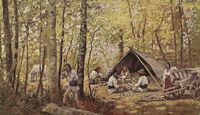
According to Herodotus, the Getae were "the noblest as well as the most just of all the Thracian tribes". When the Persians, led by Darius the Great, campaigned against the Scythians, the Thracian tribes in the Balkans all surrendered to Darius on his way to Scythia, except the Getae, who resisted. They were subjected to Scythian influence, being known as expert mounted archers.
Between the 5th and 3rd centuries BC, the Getae lived under the rule of the Odrysian Kingdom. During this time, they provided military services and became famous for their cavalry. After its disintegration, smaller Getic principalities began to consolidate themselves. Their technology was influenced by that of the invading Celts in the 4th and 3rd centuries BC. Later, in the middle of the 1st century BC, Burebista organized a kingdom consisting of the Getae, as well as the Dacians. The two peoples were related, but the Dacians lived in the mountains of what is now Transylvania, whilst the Getae flourished in the Pontic–Caspian steppe. When the Roman Empire had gained control over the region, thousands of Getae were displaced, and, not long thereafter, references to them disappeared from history.
Archeology suggests that the Snagov region had continuity, with flourishing moments about 4000 years ago and 2000 years ago. A group of furnaces for metalworking in the area was integrated into larger economic circuits. Unfortunately, the approximately 30 archeological sites located around Lake Snagov can't tell us much about the life, culture and achievements of the first people in the area, nor about the later Getae.

Snagovian ethnogenesis
The Snagovian ethnogenesis started in the period of the Slavic migrations to the Balkans in the 6th century AD. The Slavs eventually settled in Snagov, crossing the ancient forests of [[Vlăsia and establishing communities near Lake Snagov. The newly-arrived population quickly assimilated the already present Romanized Getae, and thus the Snagovian ethnogenesis started. The Seven Slavic tribes, a union of Slavic tribes that was established around the middle of the 7th century, took part in the formation of the First Bulgarian Empire together with the Bulgars around 680.
The Getae's romanized language (mainly consisting of Vulgar Latin with Thracian roots) served as a base upon which the new slavic vocabulary rested. Thus, the Proto-Snagovian language came into existence, as a Slavic language on the South Slavic branch. Unique was, and still is, the latin influence on this language, especially in grammar. The Slavs being peaceful, tolerant people with a preference for agriculture - they managed to collaborate and then even integrate into existing communities, contributing consistently to population growth and then to the promotion of their values and customs. So even in the Snagov region, we find names, place names, customs, mentalities - with obvious Slavic roots.
Not much else is known about the Snagovian ethnogenesis period. What we can assume, though, is that the slavs remained in the Snagov region and permanently established there. Their culture flourished, they cooperated with the other slavic tribes and states in the area, they adopted the Cyrillic script once it was created, they practiced agriculture, they fished, they converted to Christianity, by the 1300's, they became, Snagovians.

Integration into the Wallachian and eventual Romanian state
Foundation of Wallachia
The Snagovian lands were under the control of the First Bulgarian Empire from its establishment in 681, until the Hungarians' conquest of Transylvania at the end of the tenth century. With the decline and subsequent Byzantine conquest of Bulgaria (from the second half of the tenth century up to 1018), The Snagovian lands came under the control of the Pechenegs, Turkic peoples who extended their rule west through the tenth and 11th century, until they were defeated around 1091, when the Cumans of southern Ruthenia took control. In 1241, during the Mongol invasion of Europe, Cuman domination was ended. A direct Mongol rule over Snagov was not attested, but it remains probable.
Wallachia's creation, held by local traditions to have been the work of one Radu Negru (Black Radu), is historically connected with Basarab I of Wallachia (1310–1352), who rebelled against Charles I of Hungary and took up rule on either side of the Olt, establishing his residence in Câmpulung as the first ruler of the House of Basarab. Basarab refused to grant Hungary the lands of Făgăraș, Almaș and the Banate of Severin. Eventually defeating Charles in the Battle of Posada (1330).
There is evidence that the Second Bulgarian Empire ruled the Wallachian lands up to the Rucăr–Bran corridor as late as the late 14th century. In a charter by Radu I, the Wallachian voivode requests that tsar Ivan Alexander of Bulgaria order his customs officers at Rucăr and the Dâmboviţa River bridge to collect tax following the law. The presence of Bulgarian customs officers at the Carpathians indicates a Bulgarian suzerainty over those lands, though Radu's imperative tone hints at a strong and increasing Wallachian autonomy.
As the entire Balkans became an integral part of the growing Ottoman Empire (a process that concluded with the fall of Constantinople to Sultan Mehmed the Conqueror in 1453), Wallachia became engaged in frequent confrontations in the final years of the reign of Mircea the Elder (1386–1418). Mircea defeated the Ottomans in several battles, including the Battle of Rovine in 1394, driving them away from Dobruja.
Establishment of the Snagov Monastery


From Mircea's deed in 1408 and so on, the history of the entire Snagov region is linked in one way or another to the Snagov Monastery. From 1428 to 1429 the monastery received donations from Dan II, Vlad Dracul's cousin. In 1441, the monastery received donations from Vlad Dracul and in 1464 from his third son, Radu the Handsome. During the time of Vlad Țepeș (1448, 1456–1462 and 1476) it is considered the richest and most important monastery in all of Wallachia. This is probably one of the reasons why, at the end of the century, the Cantacuzin Chronicle claims Vlad Țepeș as the builder of the Snagov Monastery: "Vlad-Voivode Țepeș, he built the monastery from Poenari and built the holy monastery from Snagov".
On 28 October 1464 there was a document made by Vlad Țepeș, through which Vlad's younger brother, Radu the Handsome, gained more control of the Snagov Monastery. Around 1475, Vlad Țepeș orders the construction of a defensive wall, a bridge, a prison for traitors and robbers, and a tunnel under Lake Snagov. In 1476 Vlad Țepeș is killed in a battle with the Turks near Bucharest. In 1486, a document, written in Old Church Slavonic, then translated into Russian, said that when Țepeș's army drove the Turks away, he left the army alone and climbed a hill, so that he could watch how the Turks were impaled, thinking there were no enemies left there. This led to his death, as the Turks were able to catch him alone on the hill. The decapitated head of the voivode was sent to Istanbul, and the body was buried in the Snagov Monastery.
In 1512 the first church of the monastery is demolished and rebuilt from the ground up by Neagoe Basarab (1512-1521), on the site of the first construction, in the first four months of his reign. The church dedicated to the Entry of the Most Holy Theotokos into the Temple is built of brick, in Byzantine style. It is the church that can be seen today, on Vlad Țepeș Island, in the middle of Lake Snagov. Later, at the church of Neagoe, work was carried out by Mircea Ciobanul (1545–1552; 1553–1554; 1558–1559), the interior paintings, which present these last founders and their families.
On 3 April 1534 a royal deed of Vlad Vintilă from Slatina was granted to the monastery, stating that “I found out in my holy monastery, the above-mentioned monastery, the book of the great voivode Vlad Țepeș, who died in the village of Bălteni and the book of Neagoe Basarab”. This text is the origin and the proof that Vlad Țepeș was killed near Snagov, in Bălteni, in December 1476. After his beheading his body was buried in the Snagov Monastery by the monks of the monastery. In 1563, Dobromir the Young paints the church, inside are portraits of Neagoe Basarab, with his son Theodosius, and Mircea the Shepherd with his family.
In 1643, Matei Basarab (1632–1654) installs a printing press in Snagov. In 1669 the monastery becomes a political prison for boyars. Between 1696 and 1704, Anthim the Iberian, of Georgian origin, is abbot of the monastery, later metropolitan of the whole of Wallachia. Around 1700, Greek, Slavonic, Georgian, and Arabic church books are printed in Snagov and are circulated in Greece, Asia Minor, and Egypt. In 1704 the monastery passes, at the beginning of the Phanariot era, into the hands of the Greeks; being dedicated to the settlements on Mount Athos. The monastery's money was sent to Greece.
The wooden bridge built by Vlad Țepeș that connected Vlad Țepeș Island to the mainland was set on fire in 1821, and a floating bridge was built soon after. In 1847, all the Romani slaves were released, their descendants representing the Romani minority in present-day Snagov. In 1853, the floating bridge, overloaded with prisoners in chains, collapses into the water, leaving its prisoners and guards to drown in the lake. In 1863, secularization of monastic fortunes causes Greek monks to abandon the Snagov Monastery. This puts an end to the regional monopoly on religious events (especially the high fees) and allows for the beginning of church building in most communities around Lake Snagov. From this point onward, the monastery started being repaired. From 1888 to 1907, protests happen in the entire region, due to Romanian involvement in local affairs. In the 1880's, nearly a thousand Russian Lipovans migrated to the villages of Dobrosești, Siliștea and Ghermănești. It's probable that a plurality of people from those villages have Russian ancestry. It's important to note that the people that contributed to the Snagov Monastery were indeed not Snagovians, but because of their hard work and the respect they had for the locals, they are honored and respected.

Modern pre-rebirth history
Between 1914 and 1918 the First World War took place. The locals' involvement resulted in hundreds of deaths, and the plots of land promised to be distributed by the Romanians were late or not given at all. There are monuments in a lot of villages dedicated to those that died. In 1918 the first industrial fishing net was introduced, but it ceased to exist in 1996 for unknown reasons (it's believed that the Romanian government did not want the region to be economically independent, because the proximity of this economic indepence relatively close to Bucharest would be intimidating). Between 1928 and 1930, the Snagovian People's House (Snagov Palace) was built by Henrieta Delavrancea-Gibory for prince Nicholas of Romania, brother of King Carol II. Nowadays it stands as the de jure meeting place of the Supreme People's Assembly. Even though it is a symbol of Romanian occupation, it is appreciated for its architectural beauty.
In 1933, an official holiday celebrating Lake Snagov was established, because of the “Water Day” celebrated at Lake Snagov by King Carol II, Michael I, Nicolae Iorga, and many other top officials, plus representatives of the local community. Every year, locals celebrate "Lake Snagov Day" on 25 June. The assassinations of November 1938, took place in the night towards the morning of November 30, 1938, in Tâncăbești. 14 people were assassinated, prominent fascists, members of the Iron Guard, respectively, Corneliu Zelea Codreanu, the absolute leader of the movement. This is seen as an important symbol of Snagovian Anti-Fascism.
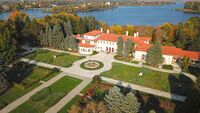
Just like in the First, in the Second World War (1939-1945) many locals took part, with hundreds of deaths all around. On 23 August 1945, Ion Antonescu left Snagov Palace to go to Bucharest, at the request of King Michael I, when and where he was arrested. Manfred von Killinger (who lived in a nearby villa in Dobrosești) soon committed suicide because he failed to keep Romania on the side of Germany, as Hitler demanded.
With the establishment of the People's Republic of Romania in 1948, some plots of land were given to the local peasants (as promised during the wars). In 1956, Imre Nagy, a former Prime Minister of Hungary, is brought and detained in Snagov. He was taken back to Hungary in June 1958 and was eventually sentenced to death. Between 1962 and 1972, an international rowing competition called Regata Snagov took place.


Between 1986 and 1989 over 400 homes in Dobrosești, Ghermănești, Ciofliceni, and Vlădiceasca were destroyed as a part of the Romanian systematization process. The villages of Ciofliceni and Vlădiceasca became nearly empty, they started being rebuilt only after the fall of Communism in Romania. From 1990 forward, nothing good happened to Snagov, other than illegal deforestation, privatization of once public places, pollution, and mafia culture. Snagov lost its spirit and it became a simple sattelite of Bucharest, just like other communes in Ilfov. Though, what makes Snagov different is that the people know they are special, and they know things are going wrong.
Snagovian Declaration of National Rebirth adopted
Beginning of the Snagovian Federal Republic
The Snagovian Declaration of National Rebirth was written collectively by a group of 25 Snagovians (its first citizens), and it was later signed by Ștefan Marius Snagoveanu and David Robert Davidovici, on 18 June 2020. The declaration talks about the Snagovians' historical struggle and its present day strive towards cultural and political liberty. The document instructs Snagovians to be proud of their nationality, of their culture, to relearn their old language, etc. The first constitution was adopted shortly after. According to this first constitution, the state was to be called the Snagovian Federal Republic. It was first divided into oblasts with land claims around every village. The first Snagovian currency, the Snagovian Krona was introduced. The first constitution also set up the bases for the Snagovian People's Army. The state defined by the first constitution was a presidential federal republic, which meant that a prime minister role did not exist at that time, thus the President was both the head of state and the head of government. Snagov's most important reason for existence at that time was to promote the protection of the environment, to condemn those that the government classified as enemies, and to praise the ones that do real work for the Snagovian local community. A huge feeling of patriotism later turned into nationalism by August 2020, and the government decided to expand their presence on the internet, mainly through MicroWiki, Twitter, and Discord, to attract people to hear Snagov’s story, to learn about its history and struggle, and to present its beautiful lands that are in danger, to the outside world. This decision turned out to be a double-edged sword.
Discord era during the COVID-19 pandemic
Due to the COVID-19 pandemic and its restrictions, the state had to function exclusively online for a long period of time. The government decided to expand its presence on Discord, to interact with people all over the world and to educate them about Snagov and the Snagovians. During this period foreigners could apply for a honorary citizenship in a village of their choosing. The state applied for organizations like the Grand Unified Micronational and the Cupertino Alliance, and ultimately got accepted in both. Awards like the Order of the 18th of June and the Order of the Federation were created and given to friends of the state, until all things related to this online era, including honorary citizenships, were removed.
Transition from the Federal Republic to the Federation
The transition from the Snagovian Federal Republic to the Snagovian Federation began on 18 June 2021 with the adoption of the second constitution. This constitution set the bases to an actual real state, for the first time. Snagov's first land claim did not include the Ialomița commune, because of geographical reasons. This was later overturned. The state transitioned from a presidential republic to a semi-presidential one, with the prime minister role being established. Albert Henry Jinga was appointed as prime minister shortly after. The Snagovian Workers' Party and the Supreme People's Assembly were established. The Army got redone, with the White Guard being created. De facto work started to outvalue de jure work. The first meeting between officials was held on 26 June 2021, when the bases for Snagovism were established. It was decided that an official meeting shall happen atleast once every month. At the end of every session environmental work was done in Siliștea and surroundings. Things such as planting trees, picking up trash, feeding stray animals, cleaning the forest, etc. In September the government began calling its enemies "vrăjmași". The government began the process of re-slavicization shortly after, by reviving the long dead Snagovian language, and by presenting the people, their history. The Snagovian Ruble was established in November and unveiled in June 2022. The government celebrated New Years by marching with the Snagovian flag on the main street of Siliștea. At the beginning of 2022, the government began supporting Russia in their military operation in Ukraine, a move that sparked controversy. In the rest of the first half of 2022 the government has found itself in an awkward position. Plans for the latter half of the year are to increase Snagovian citizenship in other villages other than Siliștea. On 12 October 2022, the name of the state was changed to the Republic of Snagov.
Administrative divisions
The Snagovian People's Republic is composed of 19 villages, split into 5 communes, except for Siliștea which don't belong to any commune.
| Flag | Name | Code | Coat of arms | Motto | Subdivisions | Population | Area (km2) | Location in Snagov |
|---|---|---|---|---|---|---|---|---|

|
Siliștea Силищєа |
SIL | 
|
În veacuri slăvită Forever glorified |
Cernograd, Coadele Maidanu, Coșarna Dumbrava, Pescari Antim Ivireanul, Turbați Sfântul Nicolae |
2398 | 12.56 km² | 
|

|
Ialomița Яломица |
IAL | 
|
Єдинства ѥ силъ Unity is strength |
Curcubeu Balta Doamnei Bâra Lacu Turcului |
2873 | 37.15 km² | 
|

|
Skrovishtea Скровищєа |
SCR | 
|
Су Бог напрєд With God forward |
Cholpanj Pisku Volkarija |
4170 | 60.16 km² | 
|

|
Snagovu Yuzhen Снагову Южєн |
SNI | 
|
Божє спасє-ни God save us |
Tankubeshtj Izvoranj Vladicheaska |
2367 | 27.42 km² | 
|

|
Snagovu Severn Снагову Сєвєрн |
SNS | 
|
Родина-ј рај зємлѥн The homeland is an earthly heaven |
Chjoflichenj Germaneshtj Dobrosheshtj |
5546 | 52.93 km² | 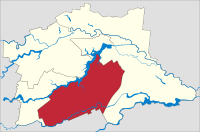
|

|
Garlitsa Гѫрлица |
GÂR | 
|
Зємлия Прєдици Land of our ancestors |
Shantsu Floreshtj Gruju Lipija Balta Cherna |
5297 | 67.16 km² | 
|



